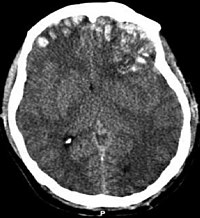
Photo from wikipedia
Purpose Fractures are common among all types of paediatric injuries, with differences in incidence over time. Here, we present the epidemiologic features of traumatic fractures in a population of youth… Click to show full abstract
Purpose Fractures are common among all types of paediatric injuries, with differences in incidence over time. Here, we present the epidemiologic features of traumatic fractures in a population of youth ≤ 18 years of age who were admitted to our university-affiliated hospitals from 2002 to 2010. Methods We retrospectively reviewed 2450 children and adolescents who had traumatic fractures. The data include variables such as age, sex, date of injury, and the mechanism of injury. For the period of 2002-2010, there were 2450 injury events that resulted in at least 1 fracture. Results Low falls (1042, 42.5%) and upper limb fractures (1068, 43.6%) were the most common aetiologies and fracture sites. With increasing age, the proportion of injuries due to motor vehicle collisions (MVCs) decreased and the injuries due to being hit by others and due to sprains increased. With increasing age, the proportion of craniofacial fractures (CFFs) decreased, and lower limb fractures (LLFs), spinal fractures (SFs), and fractures of ribs and the sternum (RSFs) increased. Over time, the proportion of injuries due to MVCs and mechanical injury decreased. Male patients presented with a significantly higher proportion of injuries due to low falls, being struck by an object, being hit by others, and due to sprains. There were a significantly lower proportion of injuries due to MVCs in female patients. Male patients presented with a significantly higher proportion of ULFs in the ≤6-year-old age group and a significantly lower proportion of LLFs and SFs in the 12-18-year-old age group than did female patients. Conclusions Low falls and upper limb fractures were the leading cause and fracture sites. To further improve the prevention and treatment of traumatic fractures in children and adolescents, policy makers should pay attention to these characteristics.
Journal Title: BioMed Research International
Year Published: 2019
Link to full text (if available)
Share on Social Media: Sign Up to like & get
recommendations!